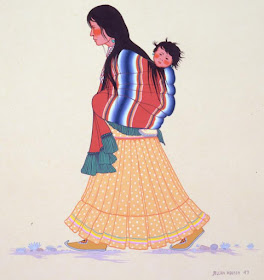Allan Houser (30-6-1914/22-08-1994), un apache Chiricahua, fue indiscutiblemente uno de los artistas más importantes de los Estados Unidos en medios escultóricos, dibujos, pinturas, tallas de madera o cualquier otro medio que eligiera para probar. Era modernista y tradicionalista, y fue sin duda uno de los artistas nativos americanos más famosos del siglo XX. En la década de 1980, su reputación estaba firmemente establecida. Sus pinturas se presentaron en una celebración de arte nativo en el Kennedy Center en Washington DC en 1981 y se incluyeron en una exhibición del Smithsonian que viajó a América del Sur. Ese mismo año, expuso en el legendario Salon d'Automne en París, Francia.
Houser es más conocido por sus esculturas porque ese es el medio en el que trabajó en la última parte de su carrera cuando era más conocido como el artista que era. Sus pinturas son más raras que sus esculturas y son muy deseadas por los coleccionistas de arte nativo.
Allan Houser (June 30, 1914 – August 22, 1994), a Chiricahua Apache, was indisputably one of America's foremost artists in mediums of sculpture, drawing, paintings, wood carving or whatever medium he chose to try. He was a modernist as well as a traditionalist and was certainly one of the most famous Native American artists of the 20th century. By the 1980s, his reputation was firmly established. His paintings were featured in a celebration of Native art at the Kennedy Center in Washington DC in 1981 and included in a Smithsonian exhibit that traveled to South America. That same year, he exhibited in the legendary Salon d'Automne in Paris, France.
Houser is most known for his sculptures because that is the medium he worked in in the latter part of his career when he was best known as the artist he was. His paintings are rarer than his sculptures and are highly desired by collectors of Native art.
Texto de Adobe Gallery

















